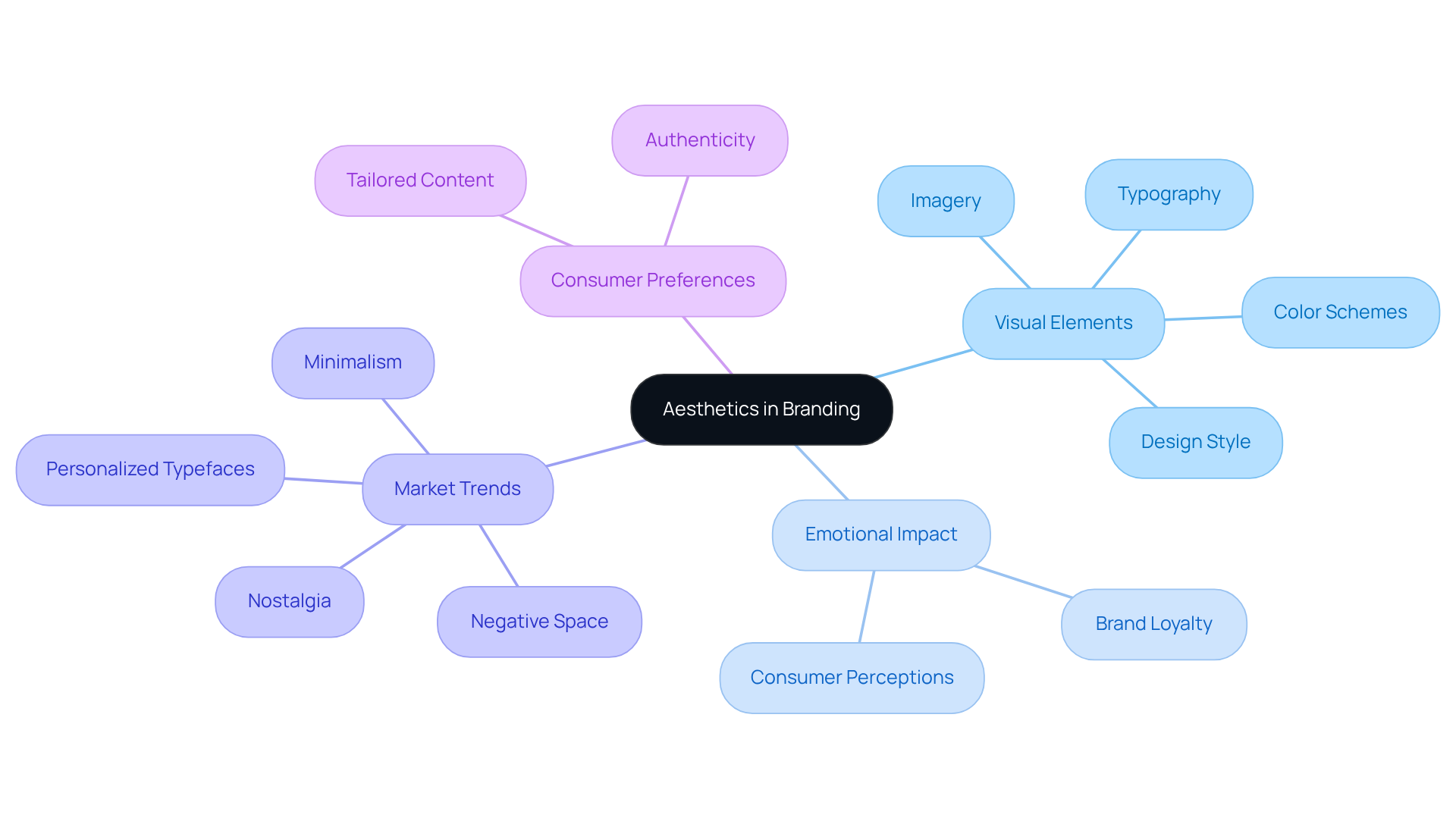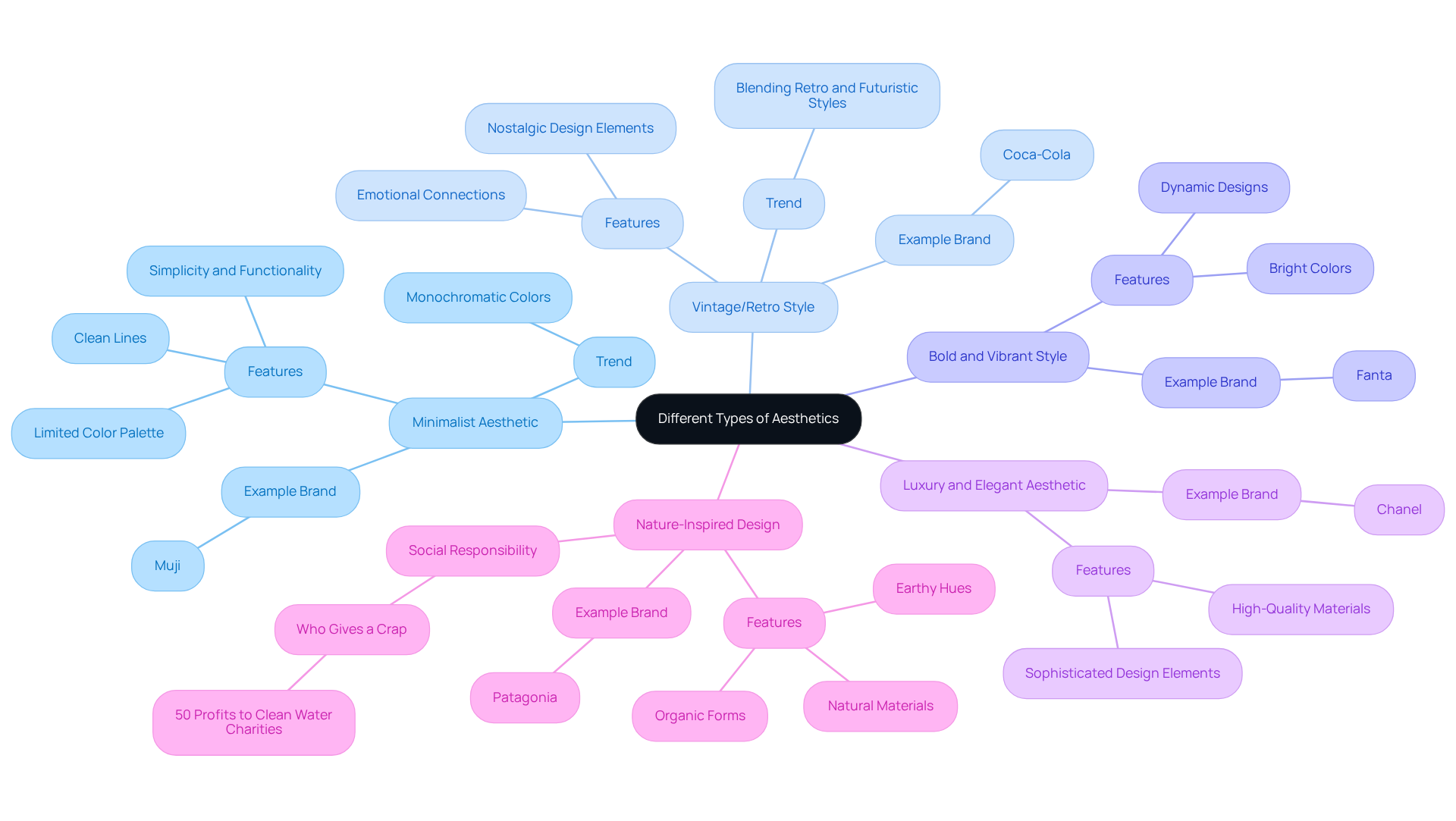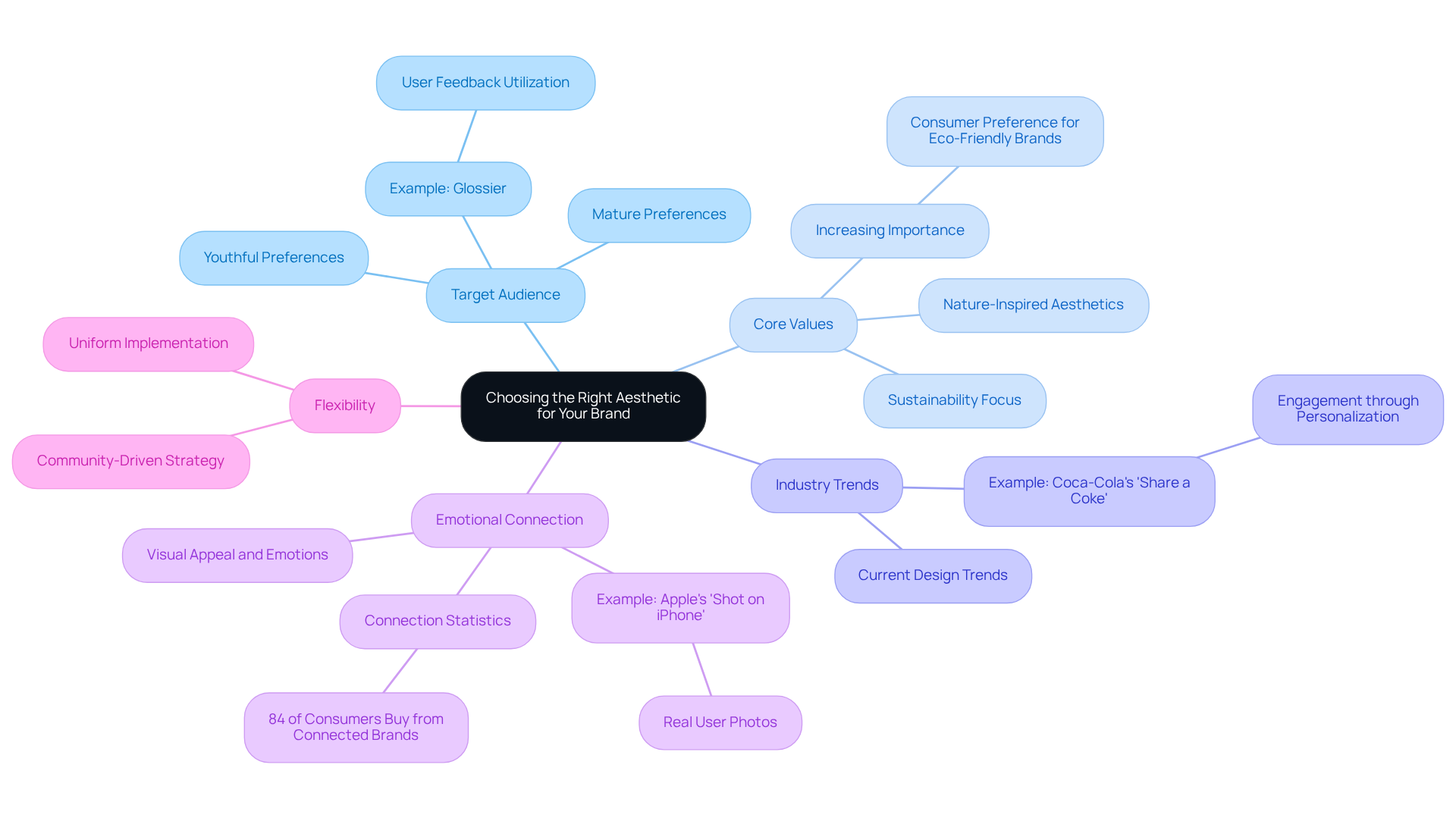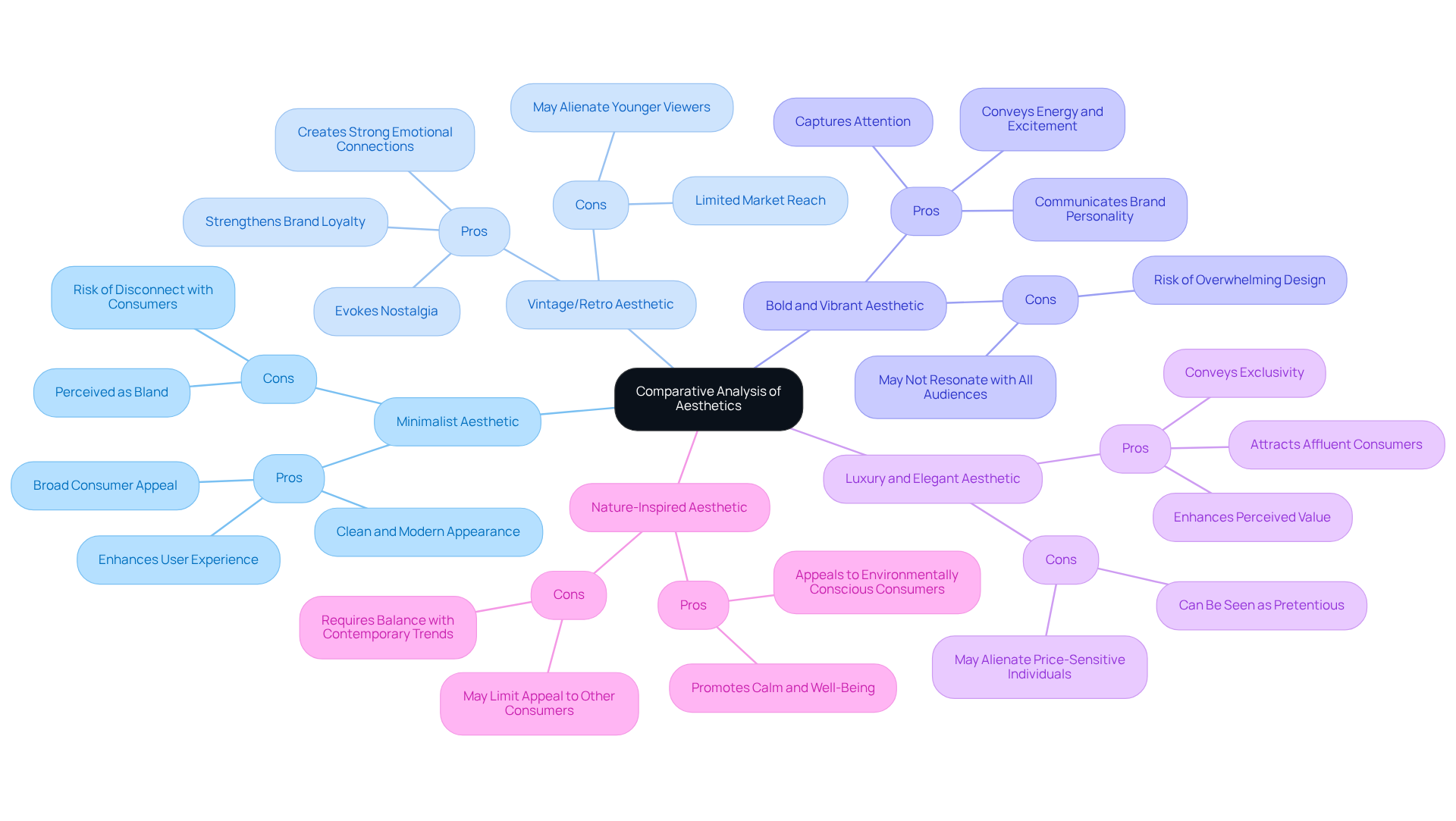4 Different Aesthetics to Elevate Your Brand Strategy

Overview
This article examines four distinct aesthetics that can significantly enhance brand strategy:
- Minimalist
- Vintage/Retro
- Bold and Vibrant
- Luxury/Elegant
Each aesthetic possesses unique characteristics tailored to diverse consumer preferences. Understanding and implementing these styles effectively can profoundly impact brand recognition, foster emotional connections, and bolster overall market competitiveness. To remain relevant in today's competitive landscape, brands must consider these aesthetics as integral components of their strategic approach.
Introduction
Aesthetics are crucial in shaping brand identity, influencing consumer perceptions, and driving purchasing decisions. In an era where visual appeal defines market presence, understanding the nuances of various aesthetics is essential for crafting an effective brand strategy. This article explores four distinct branding aesthetics—minimalist, vintage, bold, and luxury—each presenting unique advantages and challenges.
How can brands select the right aesthetic to resonate with their target audience while distinguishing themselves in a competitive marketplace?
Understanding Aesthetics in Branding
Aesthetics in branding encompass the visual elements that define an entity's identity, including color schemes, typography, imagery, and overall design style. These elements are meticulously integrated to evoke specific in consumers, significantly impacting their purchasing decisions. A thoughtfully designed appearance not only enhances recognition but also fosters customer loyalty and effectively communicates the company's core values.
In an increasingly competitive market, where consumers are presented with a myriad of options, an attractive design can set a brand apart and leave a lasting impression. For instance, iconic companies such as Apple and Coca-Cola have adeptly leveraged different aesthetics to cultivate a robust identity that resonates deeply with their target audiences, underscoring the critical role of visual appeal in successful marketing strategies.
As we approach 2025, the emphasis on aesthetics is poised to intensify, compelling companies to align their visual identities with public expectations for authenticity and engagement. Notably, the strategic use of negative space is emerging as a prominent branding concept, enhancing brand recall. Additionally, a resurgence of nostalgia for the 1960s is becoming a significant trend, allowing brands to evoke emotions and connect with individuals on a more profound level.
The shift towards personalized typefaces and text-only logos illustrates how businesses are adapting their visual identities to meet evolving audience preferences. According to Marion Andrivet, authenticity is paramount in marketing, as consumers increasingly gravitate towards brands that align with their values. Furthermore, data indicates that 75% of shoppers are more likely to purchase from companies that provide tailored content, highlighting the importance of visuals in influencing buying decisions.
As we navigate the branding landscape of 2025, grasping these trends will be crucial for corporate executives seeking to refine their brand strategies.

Exploring Different Types of Aesthetics
Brands can embrace different aesthetics, each with distinct features that cater to varying buyer preferences. Notably, several prominent aesthetics stand out:
- Minimalist Aesthetic: This approach emphasizes simplicity and functionality, often featuring a limited color palette and clean lines. Brands such as Muji exemplify this style, attracting consumers who value clarity and efficiency in their selections. In 2025, the trend of monochromatic colors is gaining traction, creating a cohesive appearance that enhances the minimalist style.
- Vintage/Retro Style: This style evokes nostalgia through design elements reminiscent of past eras. Brands such as Coca-Cola effectively utilize this style to forge emotional connections with consumers, tapping into the warmth of shared memories. The emerging trend of further enhances the significance of vintage visuals in modern branding.
- Bold and Vibrant Style: Characterized by bright colors and dynamic designs, this style aims to capture attention and convey energy. Brands like Fanta leverage this approach to engage younger audiences, creating a lively and energetic brand presence.
- Luxury and Elegant Aesthetic: This style incorporates sophisticated design elements, focusing on high-quality materials and craftsmanship. Labels such as Chanel represent this style, appealing to individuals who desire uniqueness and status in their acquisitions.
- Nature-Inspired Design: This style incorporates organic forms, earthy hues, and natural substances, attracting eco-conscious individuals. Brands like Patagonia exemplify this approach, aligning their identity with sustainability and ethical practices. Significantly, companies that highlight social responsibility, like Who Gives a Crap, which contributes 50% of profits to clean water charities, connect effectively with today's consumers.
As branding evolves, the minimalist style is gaining traction, reflecting different aesthetics that prioritize simplicity and clarity in design. Additionally, personalization has emerged as a crucial branding trend in 2025, allowing companies to customize interactions and create opportunities for user-generated content, thereby enhancing user experience and fostering deeper connections with their customers.

Criteria for Choosing the Right Aesthetic for Your Brand
When selecting , it is essential to consider several key criteria that will significantly impact your market presence.
- Target Audience: Understanding the preferences and values of your target demographic is crucial. A youthful audience may react more positively to bold and vibrant visuals, while a more mature audience might prefer different aesthetics such as minimalist or sophisticated designs. Brands like Glossier effectively utilize user feedback to customize their style, ensuring they connect with their community. This connection not only fosters loyalty but also enhances brand perception.
- Core Values: The selected visual style should correspond with your organization's fundamental principles and mission. For instance, a company focused on sustainability should adopt different aesthetics, including a nature-inspired aesthetic, to reinforce its commitment to the environment. This alignment not only enhances authenticity but also fosters a deeper connection with individuals who share similar values. As we approach 2025, sustainability is becoming increasingly significant, with buyers favoring brands that exhibit eco-friendly practices.
- Industry Trends: Staying informed about current design trends within your industry is essential. Brands that align with different aesthetics can enhance their relevance and appeal. The shift towards tailored experiences in 2025 underscores the importance of adapting to changing buyer expectations, as evidenced by successful campaigns like Coca-Cola's 'Share a Coke'. This adaptability is key to maintaining a competitive edge.
- Emotional Connection: Consider how the visual appeal can evoke emotions in consumers. A well-selected aesthetic that embraces different aesthetics can foster a strong emotional connection, resulting in heightened loyalty to the company. For instance, Apple's 'Shot on iPhone' campaign showcases real, unedited photos, emphasizing genuine moments that resonate emotionally with audiences. Notably, 84% of individuals purchase from companies they feel a connection to, highlighting the significance of nurturing these relationships.
- Flexibility: Ensure that the visual style can be implemented uniformly across different platforms and marketing materials, preserving a unified corporate identity. This consistency is essential for creating recognition and trust. Companies that effectively integrate their visual elements across touchpoints frequently experience increased engagement and loyalty from their audience. Furthermore, embracing a community-driven strategy, where customers are regarded as friends, can further enhance loyalty and engagement.

Comparative Analysis of Aesthetics: Pros and Cons
A comparative analysis of aesthetics reveals distinct advantages and disadvantages that warrant consideration:
- Minimalist Aesthetic: This style offers a clean and modern appearance, enhancing user experience through easy navigation. Its simplicity attracts a broad consumer base, making it a favored option for many companies. However, there is a risk of being perceived as bland or lacking personality, which may result in a disconnect with consumers seeking more engaging narratives. Research indicates that design-focused companies outperform the S&P 500 by 219% over a decade, underscoring the necessity for a balance between simplicity and effective branding strategies.
- Vintage/Retro Aesthetic: By evoking nostalgia, this aesthetic creates , allowing brands to stand out in a crowded market. It often resonates with individuals who appreciate authenticity and heritage, thereby strengthening loyalty to the label. For instance, companies that effectively incorporate vintage elements can cultivate deeper ties with their consumers, as nostalgia serves as a potent motivator of buying habits. Nonetheless, this approach may alienate younger viewers who do not connect with past styles, potentially limiting market reach. Brands must carefully balance different aesthetics by integrating vintage elements with contemporary relevance to maintain broad appeal.
- Bold and Vibrant Aesthetic: This style captures attention and conveys energy and excitement, making it particularly appealing to younger demographics. It can effectively communicate a brand's personality and values. However, if not executed well, it risks becoming overwhelming, leading to a cluttered appearance that may not resonate with all audiences. Brands must ensure that their vibrant designs incorporate different aesthetics that align with their core messaging.
- Luxury and Elegant Aesthetic: This aesthetic conveys exclusivity and high quality, attracting affluent consumers who appreciate refined aesthetics. Such an approach can enhance perceived value and brand prestige. Conversely, it may alienate price-sensitive individuals, as it can be seen as pretentious or unattainable. Brands should consider different aesthetics in their messaging to avoid alienating potential customers.
- Nature-Inspired Aesthetic: This style appeals to environmentally conscious consumers, promoting a sense of calm and well-being. It aligns with increasing buyer preferences for sustainability and ethical practices. However, it may limit appeal to consumers who prefer different aesthetics, necessitating a careful approach to branding that balances nature-inspired elements with contemporary design trends.

Conclusion
A brand's aesthetic transcends mere visual choice; it stands as a pivotal strategic element that shapes consumer perception and engagement. By grasping and implementing the appropriate aesthetic, brands can forge a compelling identity that resonates deeply with their target audience, ultimately driving loyalty and sales. The exploration of diverse aesthetics, ranging from minimalist to vintage, underscores the myriad options available for brands to articulate their values and connect emotionally with consumers.
Throughout this article, we have illuminated key insights regarding the necessity of aligning aesthetics with target audiences, core values, and industry trends. The examination of the advantages and disadvantages of various aesthetics provides invaluable guidance for brands navigating the intricate landscape of visual identity. As trends increasingly lean towards personalization and sustainability, the capacity to adapt and select the right aesthetic becomes essential for maintaining relevance in a saturated market.
In conclusion, the importance of aesthetics in branding is paramount. Brands that meticulously consider their visual identity and its alignment with consumer values will not only amplify their market presence but also cultivate deeper connections with their audiences. By embracing evolving trends and recognizing the emotional impact of design, companies can elevate their brand strategies and secure enduring success in 2025 and beyond.
Frequently Asked Questions
What are the key components of aesthetics in branding?
Aesthetics in branding include visual elements such as color schemes, typography, imagery, and overall design style that define a brand's identity.
How do aesthetics impact consumer behavior?
Aesthetics evoke specific emotions and perceptions in consumers, significantly influencing their purchasing decisions and enhancing brand recognition and customer loyalty.
Why is a strong visual identity important in a competitive market?
An attractive design helps a brand stand out among numerous options, leaving a lasting impression on consumers and contributing to effective marketing strategies.
Can you provide examples of companies that successfully use aesthetics in branding?
Iconic companies like Apple and Coca-Cola have effectively leveraged different aesthetics to cultivate a strong brand identity that resonates with their target audiences.
What trends in branding aesthetics are expected to emerge by 2025?
By 2025, there will be an increased emphasis on aligning visual identities with authenticity and engagement, the strategic use of negative space, and a resurgence of nostalgia for the 1960s.
How are brands adapting their visual identities to meet audience preferences?
Brands are shifting towards personalized typefaces and text-only logos to align with evolving audience preferences and expectations.
What is the significance of authenticity in branding?
Authenticity is crucial as consumers are increasingly drawn to brands that reflect their values, making it a key aspect of effective marketing.
How does tailored content influence consumer purchasing decisions?
Data shows that 75% of shoppers are more likely to purchase from companies that provide tailored content, highlighting the importance of visuals in influencing buying behavior.


